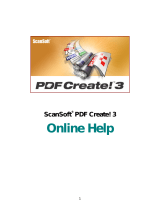
10
The Nuance PDF Settings for Word dialog box
This can be accessed from a toolbar button or an item in the Nuance
PDF menu. (In Word 2007 you can find this in the Nuance PDF tab.) It
lets you define settings that are applicable only when creating a PDF
from a Word document. Define which paragraph styles in the Word
document should be converted to bookmarks in the PDF, which
comments should be transferred and how hyperlinks should appear.
Create PDFs from Microsoft Excel and PowerPoint
1. Open the Excel file or PowerPoint presentation.
2. Select Create PDF from the Nuance PDF menu or click .
3. Accept or change the default target folder and file name in the Save
As dialog box that appears.
4. To create a PDF and attach a copy of it to an e-mail, click .
5. To change creation properties, click .
NOTE: If you do not see the buttons in Word, Excel or
PowerPoint, go to View > Toolbars and select Nuance PDF.
ScanSoft PDF Create! Properties dialog box
This gives you full control over the conversions. In the General panel you
define page size, orientation, resolution for the PDF and choose whether
or not to view it after creation. The PDF Settings panel lets you define
the PDF version, control font embedding, set compression types and
severity, define passwords and add watermarks. It gives you choices for
naming the created PDF file(s) and defining properties such as title,
author, subject and keywords. The created file(s) can also be directed as
attachments to an E-mail message, ready for distribution.
The ScanSoft PDF Create! Properties dialog box can be accessed from the
Print dialog box in your applications. When working from the Create!
Assistant or Windows Explorer, these settings are made through the
profiles. If you need to access these settings from Microsoft Word,
choose File/Print instead of the PDF Create! button.













